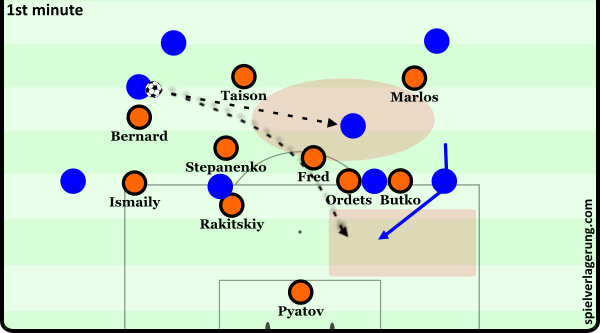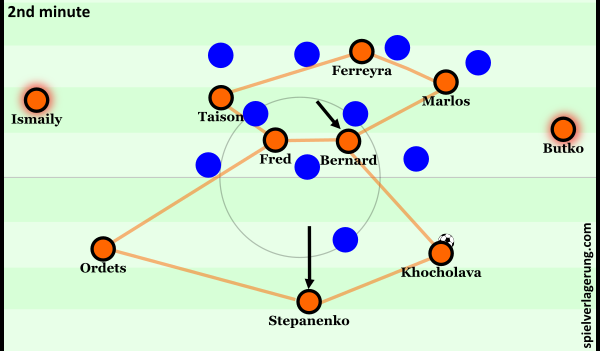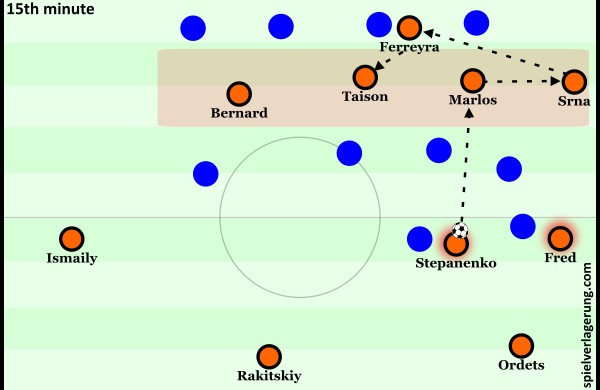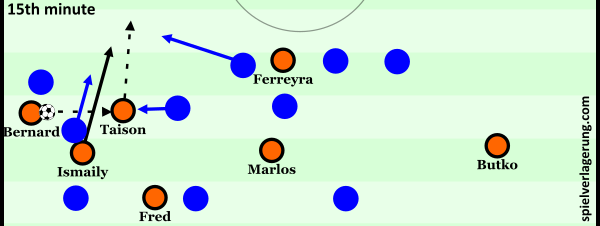シャフタール・ドネツクの4−2−3−1。
後編になります。
画像、原文は以下のサイトからの引用になります。
https://spielverlagerung.com/2018/02/19/shakhtar-team-analysis/
Strengths that become weaknesses
But still: Compared to the, at times extraordinary medium block, Shakhtar’s higher press is noticeably worse. One important aspect to this is that you almost can’t be as compact when you press in the opponent’s half as in a medium block because the offside rule is only applied from the halfway line downward. Many of the pressing patterns are implicitly based on the players being close to each other. Such situations need to be created differently in the opponent’s half than in the deeper pressing (e.g. situational compactness versus general compactness).
Even in their own half the sometimes-forceful forward defending of Fred can be used against Shakhtar when he follows a dropping moment for a short moment and Marlos is rather focused on keeping the winger in his cover shadow. Then both of them neither block the passing lane through the half-space nor is the team ready to create the usual staggering in reaction to a pass into this area. This can already become problematic in small spaces against strong opponents.
On one hand, a 2vs1 on Butko could easily be created, if he doesn’t step up. If he does, the timing and the direction of him attacking the ball need to be good enough to prevent a pass towards the wing and consequently lead to an easy breakthrough. Butko can be quite successful in this, but more when a pressing situation is pre-planned rather than a result of not executing the plan perfectly.
On the other hand, Fred is relatively quick to react to such small mistakes and can compensate them thanks to his individual intensity. As a result, the player he previously marked might become the free player for an immediate back pass from the wing. He can’t be attacked as soon as needed, then, and is able to switch towards the other side where the opponent could use a dynamical or individual advantage to break through. Although Shakhtar defends switches of play quite well overall, with bigger space between the defending players the advantage on the near side could already be used much easier by the opponent.
Example from Matchday 2 vs Manchester City, 26-09-2017The compactness missing in other moments can become too much in situations where the ball is on the wing, right at the edge of Shakhtar’s own third. This can also have an obvious negative impact that all opponents in the Champions League group stage used to their advantage in order to create dangerous situations close to the penalty area.
Even on the far side, the back four tries to position itself as high as possible and as close to the midfield as possible. If the opponent makes a run into depth in the ball-near half-space, the nearby centre-back tends to follow this movement because employing an offside trap would be quite risky as the opponent’s run already starts 10 to 15 metres away from the back four.
So, for a short moment the ball-near centre-back is positioned deeper than the other defenders. If there’s not enough pressure on the player in possession of the ball on the wing, an easy pass behind the back line can be executed. Thus, a late run of a centrally positioned player (mostly the striker), can beat the whole pressing action.
Example from Matchday 2 vs Manchester City, 26-09-2017Once the ball reaches an area surrounding Shakhtar’s own penalty area, at least the rear part of the team tends to drop back quickly while other players stay in positions higher up the field for possible counter attacks. Fred again moves far away from the centre to press the ball or to support his team mates. Stepanenko now needs to evaluate whether he should do the same close to his own goal or whether he should continue to protect the centre.
Based on this decision he either allows the opponent to have a numerical superiority at the edge of the penalty area or the backfield stays open for passes (i.e. cut-backs) of the opponent from lateral zones. Shakhtar’s players in deeper positions generally can’t react to this decisively anymore and the backward pressing usually can’t work close to the own box like it does higher up the field.
Example from Matchday 2 vs Manchester City, 26-09-2017The slightly advanced positioning of the ball-far winger can also become a problem next Shakhtar’s own box as it opens up a direct way for a switch from half-space to half-space for the opponent. Also runs from deeper starting positions aren’t followed consistently which leads to a vulnerability towards chip balls to the second post. Adding to that, the back four doesn’t cover the space behind their backs well enough in these situations but rather focuses on marking players in front of them.
弱点となる強み
しかし中盤の素晴らしい守備ブロックに比べてシャフタールの高い位置からのプレスは目立って悪くなります。重要なポイントはハーフウェイラインで適用されるオフサイドルールがあるために相手陣地でプレスを掛ける時にコンパクトさを保てないのです。多くのプレスのパターンは選手同士の間を狭くすることが基本になっています。より高い位置である相手陣地ではまたちがった形をを作る必要がでてきます。(例えば、一般的なコンパクトに対する状況的なコンパクト)
シャフタールへの対抗策として自陣であっても力強く前に出ていくフレッジの守備が利用されてしまいます。彼が落ちる動きについてくる少しの時間とマルロスがカバーシャドウのためにサイドに残る事に集中している瞬間です。どちらの動きもハーフスペースへのパスコースを防ぐことができす、チームもまたこの場所へのパスへの対応を準備できていません。これは小さいスペースですが強豪チームに対しては問題になってきます。
一方でブトコはもし前に出ていないと簡単に2対1を作られてしまいます。彼がそうした場合、ウイングへのパスを防ぐのに最適なタイミングと角度が必要になり、結果的には突破口を与えてしまうことになります。ブトコはこの守備を大抵は成功させるのですが、プレスを掛ける時には事前に設計されているわけではなく結果的にそうなっているだけのようです。
それとは別にフレッジはこの様な小さなミスに比較的素早く反応して彼のインテンシティの高さにより補っています。結果として彼が元々マークしていた選手はサイドの選手からの素早いバックパスを受けることでフリーになる可能性があります。ボールを受けた選手はすぐにプレスを受けずに逆サイドに展開することができ、突破のためのダイナミックな動きや個人の優位性を使うことになります。シャフタールはサイドチェンジを全体的によく守ってはいますが、選手間の距離があきスペースが大きくなるので狭いサイドよりも相手にとっては楽に使うことができます。

2017年9月26日マンチェスター・シティ戦
他の場面でいうとシャフタール側の陣内の右サイドにボールがあるとコンパクトさが失われる事がよくあります。このはっきりとした弱点はチャンピオンズリーグの対戦相手にとってペナルティーエリア近くでチャンスを作るために利用できると取られたでしょう。
遠いサイドにボールがあるときでさえ、4バックは可能な限り高いポジションを取り中盤のスペースを狭くしようとします。もし相手がボール近くのハーフスペースの奥に走り込んだとすると近くのセンターバックがこの動きについていくので、4バックの10〜15メートル前からすでに走り始めている相手に対してオフサイドトラップを仕掛けていることは大変リスクのある動きです。
だからボール近くのセンターバックは他のDFよりも低い位置をとる時間が発生します。サイドでボールを持つ相手に十分にプレッシャーをかけていないと、DFラインの裏に簡単にパスを出されてしまいます。したがって中央に位置する選手(たいていはFW)が遅れて走ることでプレッシングを全て無効にできるのです。

2017年9月26日マンチェスター・シティ戦
シャフタールのペナルティーエリア周辺にボールが送られると、一部の選手は素早く戻る一方で他の選手はカウンターアタックに備えて高い位置を保ったままです。フレッジはボールへプレスを掛けるか味方のサポートのために再び中央から離れてしまいます。ステパネンコはゴールに近づいて守るべきかそれとも中央を守り続けるべきか判断する必要に迫られます。
彼が判断をする基準はペナルティエリアの端で数的優位を作られるか、サイドからのパスコースを開けてしまうという事です。低い位置を取っているシャフタールの選手達はどのような判断でも反応することができず、低い位置でプレスを掛けることはより高い位置でそうするようにペナルティエリアの近くで守備を出来ないことになります。

2017年9月26日マンチェスター・シティ戦
ボールから離れたサイドの選手がすこし高い位置を取ることはハーフスペースからハーフスペースへの切り替えによってフリーになることにつながり、シャフタールのペナルティエリアに問題を起こします。低い位置から走り出すことに対しては一貫して守備についていきません。ファーサイドへのチップキックに対して弱みを持つことになります。加えて、4バックは背後のスペースへのボールをカバーしません。むしろ彼らは前方の選手をマークすることに主眼を置いているのです。

2017年10月17日フェイエノールト戦
Flexible central focus
Shakhtar Donetsk would be a way less interesting team, if it only had some special or well drilled elements in pressing. The team of Paulo Fonseca also has a lot to offer in possession of the ball, beginning with the general structure.
The base is a 4-2-3-1, a formation that is often interpreted as more of a 4-4-1-1. The wingers might tuck inside but more in relation to the respective full-back while striker and No. 10 interact with each other. Not so in Shakhtar’s case: They actually play with three No. 10s as attacking midfielders whose position is clearly between the lines.
From there, they can still move outside towards the wing areas, but this space is never left unoccupied. Holding the width is mainly the job of the full-backs. Striker and the central No. 10 still position themselves in relation to each other for not being on the same passing line. But Ferreyra’s role is clearly different from Taison’s. He is the main option to be found when escaping from certain situations and acts according to the behavior of all three No. 10s.
If we look at the deeper players, it’s also quite noticeable how both defensive midfielders oftentimes play very close to each other while the centre-backs spread out wider than them. Like that, they create a trapezoid which is narrower at the top than at the bottom and can also become a flat 4 at times with the centre-backs occupying the positions on the outside.
Thanks to this, the defensive midfielders don’t block direct passes towards the outside midfielders and can be used to attract the opponent centrally by themselves. By doing this, they can even widen possible passing lanes. At the same time, the proximity of the deep midfielders allows quick interactions between themselves and can also facilitate a further progression towards Ferreyra or the players around him with the wing areas being an alternative route.
Example from Matchday 2 vs Manchester City, 26-09-2017Shakhtar doesn’t only have one structure to build up from. It’s more like a starting point to flexibly build a different staggering for implementing specific game plans or to execute actions based on the behavior of the respective opponent.
It’s not a rarity to see Paulo Fonseca’s team lined up in what is basically a 3-diamond-3 with the full-backs playing a bit of a deeper role compared to the classical variation of it. Stepanenko completely drops between the centre-backs. Fred stays in the spot of the defensive midfielders while the two outside midfielders effectively become central midfielders.
Example from Matchday 2 vs Manchester City, 26-09-2017This 3-diamond-3 offers a fluent passage towards a 3-2-4-1 which is mainly related to the role of the central attacking midfielder. Taison (and also Bernard at times) likes to drop from this position while Fred stays a bit higher up the field and is able to also move to the side originally occupied by Stepanenko who once again positions himself between the centre-backs.
Example from Matchday 4 vs Feyenoord, 01-11-2017These flexible build-up formations can be used to attract the opponent to wide areas to return to the centre from there. For that, the ball-near outside midfielder can drop for example, to create a diamond structure on the side which offers enough options to combine without changing the point of the attack. This can even be enhanced by Ferreyra also moving to the same side. In case of losing the ball, there’s always enough cover to win it back or to drop quickly.
Because one defensive midfielder drops at the same time, the opponent wants to avoid backward passes to him. Moreover, three players hold their positions centrally as the ball-far full-back pushes up. While maintaining a focus on the areas around the ball, Shakhtar creates enough outlet options away from it which adds difficulty for the opponent to defend.
If they directly mark the defensive midfielder in the six space, there’s less access on the two remaining No. 10s in the centre. If all of them are covered right away, the ball-far full-back can be reached more easily. If he is marked too early, one of the other three players is open, once again. If the focus of the opponent on ball-far areas gets too big overall, Shakhtar will just progress through the same side anyway.
柔軟な中盤
シャフタール・ドネツクがもし特別で訓練されたプレッシングだけのチームなら興味は持たれなかったでしょう。パウロ・フォンセカのチームは基本形から始まるボール保持の多彩さを持っています。
ベースは4−2−3−1でこのフォーメーションはよく4−4−1−1の亜種と解釈されます。大抵はFWと10番選手が互いにつながりを持ち、内側に入ることもありますが同じようにウイングはサイドバックと連携を持ちます。けれどもシャフタールには当てはまりません。彼は実際には攻撃的なMFである3人の10番選手により攻撃を仕掛けています。
彼ら3人は外側に開くこともできますがこのスペースは決して開くことはありません。幅をとるのはサイドバックの役割です。FWと中央の10番は同じパスコース上にはいないので互いに連携できる位置です。しかしフェレイラの役割はタイソンとはっきりと異なります。彼は特定の状況から脱出するときの主要な選択肢であり、3人の10番による振舞いに従って動いています。
より低い位置に居る選手を見てみると、両方の守備的MFが非常に近い位置をとる一方でセンターバックは彼らよりも広がって居ることにすぐに気づくでしょう。このように彼らは底辺よりも上が狭い台形の形をとり、時にはセンターバックが外側にポジション取りすることでフラットな4バックになることもあります。
この動きのおかげで、守備的MFは外側にいるMFへのパスコースを防がれず相手を中央に引きよせる事ができます。これによりパスコースをさらに広げることができます。同時に低い位置のMFが近づくことにより彼ら自身の間に相互作用を可能にして、フェレイラや他の選手達にむけて前進を促すことになります。そして迂回路としてサイドを使うこともできます。

2017年9月26日マンチェスター・シティ戦
シャフタールのビルドアップの型は一つだけではありません。特定のゲームプランを実行したり、それぞれの対戦相手のふるまいにもとづいてアクションを起こしたり、といった異なる戦略を柔軟に組み立てるための出発点の様なものです。
パウロ・フォンセカのチームで中盤ダイヤモンドの3−4−3の並びを見ることは珍しいことではありません。このときサイドバックは古典的なバリエーションに比べると少し役割がちがいます。ステパネンコはセンターバックの間に完全に落ちる動きをします。フレッジは守備的MFの位置にとどまり、2人のサイドMFは実質的に中方のMFになります。
中盤ダイヤモンドの3−4−3は中央の攻撃的なMFの役割によって3−2−4−1へと滑らなかに変化します。タイソン(時にはベルナルドが)ポジションから落ちる動きをして同時にフレッジは少し高い位置をとります。センターバックの間へと移動しているステパネンコが元々いた場所に移動することも可能です。

2017年11月1日フェイエノールト戦
これらの柔軟なフォーメーションによるビルドアップは相手を広い範囲に引きつけてた後に中央にボールを戻すために使われています。たとえばボールに近いサイドMFが落ちることによってサイドでひし形を作り、攻撃のポイントを変えずに必要な連携を取ってプレー選択肢を作り上げる。フェレイラが同じサイドに移動すること彼の能力を発揮できる。ボールを失った場合でも取り返したり素早く撤退できるように十分にカバーができています。
同時に1人の守備的MFが下がる動きをするので、相手は彼への後方のパスを避けたがる。さらに3人の選手は中央でポジションを保ち、ボールから離れたサイドバックは押し上げます。ボール周辺に焦点を合わせながらシャフタールはそこから逃れる選択肢を持っているので相手は守るのが難しい。
もし相手が6番の場所で守備的MFがマークしようとすると中央の2人の10番へのマークが出来なくなってしまいます。しかしもし守備側が正しいポジション取りをしていたら、攻撃側はボールから離れたサイドバックに簡単にボールを届けることができます。相手のマークする動きが早すぎると10番選手へのパスコースが再び開くことになるでしょう。そして守備側がボールから離れた場所を気にして広すぎる範囲をカバーしようとすると、シャフタールは同じサイドをあらゆる方法で突破しようとするでしょう。

2017年9月13日 ナポリ戦
The big Ukrainians and other ways to progress
This aspect can for example be exploited by a guy I already introduced: Yaroslav Rakitskiy. It certainly helps that he is proficient passing with both feet. At times, a lot of players surround him as the six space is a focal point in the build-up. The opponent tries to cut Rakitskiy off from this area which doesn’t bother him too much.
After all, the Ukrainian likes passing in a wider range better and can for example switch the play from one half-space to the opposite wing. His flat passes from one half-space to the other are even more spectacular. Taison might specifically drop for one of these while his two Brazilian mates stay centrally higher up the field.
Example from Matchday 2 vs Manchester City, 26-09-2017If the opponent would now again decide too early to prevent a switch, a passing lane between the lines would open up for Rakitskiy and he can connect to Bernard with one pass for instance.
From time to time, Andriy Pyatov can do similar things. The concept of attracting the opponent in one area to play towards another part of the field is rather transferred to a vertical layer in this case. For that, it becomes particularly important to hold the 2-2 or diamond structure of centre-backs and defensive midfielders. The goalkeeper needs enough options to progress via short passes on the ground as the opponent often reacts by directly marking the closest options.
Thanks to that, the three players that occupy the space between the lines higher up can be brought into play even when a small gap breaks open. After one of them receives the ball, they can immediately interact with each other. A typical pattern would be for example that Marlos gets the ball and dribbles slightly inside while Bernard moves away from the defender in his blind side and creates an ideal angle for a diagonal pass.
He can then receive the ball by himself in an open body position which allows for a dribbling into open space while facing the opponent’s goal. The other players in front of him even increase this advantage by attacking the space behind the back line (diagonally), pulling direct opponents or the entire back line with them.
Example from Matchday 1 vs Napoli, 13-09-2017Attracting the opponents deep in central areas can also be used by Pyatov for high (chip) balls towards the wing. His execution isn’t always absolutely clean but also never totally atrocious. But still, it’s comparably easy for the opponents to access Ismaily or Butko in these situations.
It can be avoided by creating options to quickly redirect the ball into the space behind the opponent’s full-back. Alternatively, one of the four build-up players can adjust his positioning in a way that an immediate backward pass is possible for the full-back. While focusing on attacking the space between the lines, Shakhtar doesn’t shy away from keeping the ball through passing towards their own goal until a good moment to progress arises.
Example from Matchday 2 vs Manchester City, 26-09-2017If the pressure close to the ball becomes too high and neither a controlled switch of play nor a combination on the ground is possible, there’s still another way to reach the next layer: Playing long balls towards Facundo Ferreyra. He positions himself to be the auxiliary option for just this and is able to use his skills to control and distribute high balls even against two or more opponents.
大きなウクライナ人による前進法
これはすでに紹介しているヤロスラフ・ラキツキーを活用した例です。彼がパスを両足で器用に出せることを利用しています。ビルドアップで焦点になってくる6番選手のスペースで彼が取り囲まれている事が時々あります。厄介な事にならないように相手はラキツキーをこの場所に関わらせない様に試みます。
結局の所、このウクライナ人はサイドへのパスの範囲が広く、例えばハーフスペースから逆サイドまでパスを出すことができます。ハーフスペースから逆のハーフスペースまで届かせる低いパスにさらに素晴らしい物を持っています。タイソンはよく落ちる動きをしてパスを受け、残り2人のフラジル人選手はフィールド中央の高い位置をとります。

2017年9月26日マンチェスター・シティ戦
サイドチェンジを防ぐために早すぎる決断をしてしまうと、ラキツキーによってはライン間にパスコースが開くことになり、例えばベルナルドへ一本のパスでつなぐことができます。
時にはアンドリー・ピアトフが同じ事をします。フィールドの別部分に向かうためにある場所に相手を引きつけるという狙いでこの場合は垂直方向への移動になります。そのためにはセンターバックと守備的MFが2−2またはひし形の構造を保つことが重要になってきます。対戦相手は最も近いパスコースをマークすることになるのでゴールキーパーにはショートパスの選択肢が十分に用意されている必要があります。
このおかげでより高い位置のライン間のスペースを占めている3人の選手達は小さいギャップが広げることになりプレーできるようになる。彼らの一人がボールを受けた後に、彼らはすぐに連携をとることができます。典型的なパターンは、例えばマルロスがボールを受けた時に少し内側にドリブルし、ベルナルドはデフェンダーの死角に動きます。そして斜めのパスに対して理想的な角度の位置取りをします。
彼は前を向いてボールを受けることができ、フリーで相手のゴールに向かってドリブルします。彼の前にいる他のプレイヤーは、相手やDFライン全体をひきつけてラインの裏側を攻撃することでさらに有利になる。

2017年9月13日 ナポリ戦
中央の低い位置から攻撃するときにはピアトフがボールをサイドに出します。彼の出すパスがいつもキレイにつながるという訳では無いですが、決して見込みがないという事ではありません。それでも、この場面ではスマイリーやブトコへ相手が守備につくのは比較的簡単です。
相手のサイドバックの後ろのスペースへとボールの方向を素早く変えるという選択肢を持つことでこれを回避できます。あるいは4人のビルドアップを行う選手のうち一人がすぐに後方のパスを出せるようにポジションを調整します。ライン間のスペースを攻撃することに焦点を当てながら、シャフタールは前進のための良い状況が訪れるまで、ボールをキープしつつ自陣のゴールに向かってバックパスを出すことを躊躇しません。

2017年9月26日マンチェスター・シティ戦
もしボールへのプレッシャーが強くなりすぎてサイドチェンジや連携プレーが出来なくなった時には、次の層へと到達させる別の方法があります。それはフェレイラに向かって長いボールを蹴ることです。彼はこの状況での補助的な役割であることを自身で位置づけていて、2人かそれ以上の相手でさえもボールをコントロールして配球役になるスキルを持っています。

2017年9月13日 ナポリ戦
From centre to wing and back–or why combination dribblers are so powerful
Playing between the lines is not only for actually progressing centrally, though. It’s generally a common feature to create a free player on the wing through initial central progression. He can then, like Ismaily would do, move forward with the ball and dribble by himself or play back to the centre again, say diagonally towards the striker or horizontally to another free player (on the far side) between the lines.
Compared to the player who receives a vertical pass between the lines, his team mate on the outside has the advantage to be positioned towards the field, facing the whole situation. His orientation starts quite early, basically when the pass between the lines is played. Thanks to that, he can choose a way to progress the game before anybody else. At the same time, the combination pattern of “up-outside-inside” leads to an ever-changing orientation for the opponents who almost need to turn in a (semi-)circle close to the ball in order to track it.
Example from Matchday 1 vs Napoli, 13-09-2017In this, another integral part of Shakhtar’s game becomes visible: The three attacking midfielders are, without question, strong in combination play but in the end, feel most comfortable when they can dribble with the ball. That’s why they also like to move into wider positions at times where they can solve a situational 1vs1 or 1vs2 without any problem. The diagonal play through the centre can also be used to play from one side of the field to the other relatively close to the goal. Ideally, an advantage on the far side can be created and used.
The centre is something like a “hub” for the game which also is its most natural function. On the right side, Shakhtar then mainly looks for Marlos who likes to go a bit wider by himself early on. Butko then mostly overlaps from behind and both of them can create a dynamical advantage.
Example from Matchday 3 vs Feyenoord, 17-10-2017On the left side the combinations are rather played in a triangle. On one hand, this is related to Ismaily being a clearly more creative and versatile player than Butko. On the other hand, the central attacking midfielder also tends to move towards this side of the field. Because Ferreyra can additionally occupy other players, quick combinations into the space between full-back and centre-back are a common way of breaking through.
For possible crosses, Shakhtar occupies the penalty area quite well. The ball-far players tuck inside, Fred attacks from behind. This also allows Paulo Fonseca’s team to apply a situational counterpressing in those areas. This aspect of the game is one of the least developed at Shakhtar. Especially Fred and Stepanenko are generally pretty active after the team loses the ball, but the other players stay quite passive higher up the field.
Individually one of them goes after the ball from time to time and it’s still not easy for the opponent to escape from such situations as the structure in possession is always tight enough to not allow simply passes away from it. But the focus is clearly on returning to the defensive structure as quickly as possibly instead of tying up the opponents in their own half. This fits Fonseca’s preferences quite well but nonetheless means some lost potential.
中央からサイドや後方に:ドリブラーの連携が強力な理由
ライン間でのプレーは実際のところ中央突破だけではありません。一般的には中央で前進することでサイドにフリーの選手を作ります。イスマイリーがするように自分でボールを持ち上がったり中央に戻すことは、FWの方に斜めに動いたりフリーマンになるためにライン間を横に移動します。
ライン間で縦パスを受ける選手に比べて、外側にいる彼のチームメイトはフィールド全体を見渡せる有利なポジション取りをしています。彼の方向転換はとても素早く、ライン間でプレーすることは基本です。そのおかげで誰よりも速く前に進む方法を選ぶ事ができます。それと同時に”前ー外ー内”の連携パターンが、ボールを追いかけるためにボール近くの円(半円)の範囲で方向転換する必要のある相手の向きを次々に変化させます。

2017年9月13日 ナポリ戦
ここでシャフタールの試合でもう一つ重要になる部分がみえてきます。3人の攻撃的MFは間違いなく連携プレーが強力ですが最終的にはドリブルすることを最も得意とすることです。そのため彼らは1対1や1対2の状況でも問題にせずより広いポジションへと移動することができます。中央を斜めに進むプレーはフィールドの一方のサイドから比較的ゴールに近い場所に向かうために使われます。理想的にはファーサイドに有利な局面を作って利用します。
中央の選手は”ハブ”のようなものでゲームの中で自然と重要な役割になります。シャフタールは右サイドでは早めに幅をとっているマルロスを主に探します。ブトコは主に後ろからオーバーラップをかけて、彼ら2人で積極的に有利な場面をつくります。

2017年10月17日フェイエノールト戦
左サイドでは三角形をつくり連携プレーを行います。これはイスマイリーがブトコに比べると創造的で多彩な選手であることが関係しています。一方で中央の攻撃的MFはこちらのサイドに向かってくる傾向があります。フェレイラはその他の選手が加わってくるので、サイドバックとセンターバックの間のスペースで素早い連携を行い突破するためのよく使われる方法です。
クロスの可能性を高めるためにシャフタールはペナルティエリアに人数をかけます。ボールから遠いサイドの選手は内側に入り込み、フレッジは後方から攻撃に参加します。これによりパウロ・フォンセカのチームはこの場所でカウンタープレスを掛ける事もできます。この局面はシャフタールに発展の余地がある部分です。特にフレッジとステパネンコはボールを失った時にはアクティブに行動しますが、他の選手はフィールドの高い位置にとどまったままなのです。
時々彼らの個人としてはボールを追いかける事もあります。シャフタールがボール保持の構造を作っている状況では、そこからパスで簡単にかわせるだけの十分なスペースが常にないので対戦相手が逃れることは簡単ではありません。けれども、シャフタールは相手を捕まえるのではなく可能な限り素早く守備体型に戻る事に焦点を当てていることがはっきりしています。これはフォンセカの好みではありますが、それでも可能性を失っているとも言えます。

2017年マンチェスター・シティ戦
Conclusion: Highlight as twilight
If you look at the overall situation of Shakhtar Donetsk realistically, you’ll find a team playing at the peak of what is possible with the current roster. The key players are either already around 30 years old like Taison or close to move towards the next career level like Fred.
The same could be true for the coach himself: Paulo Fonseca’s contract runs out at the end of the season. An extension isn’t very likely due to the overall situation and also because the good performances in the Champions League already caught the interest of bigger clubs.
For example, Fonseca could be quite a suitable successor for Diego Simeone at Atlético Madrid, if his era there will really end, soon. The Portuguese would likely implement a lot of features against the ball that resemble the ones already put in place by Simeone while being able to enhance the possession game with some fresh ideas.
As somebody who isn’t your typical positional play coach but rather obsessed with being clearly organized in all phases of the game he would be an ideal fit for the working-class DNA of Atlético. At the same time, he would find players in Madrid capable of doing at least the same things that Shakhtar does at the moment.
His current team is still in contention to advance to the Champions league quarter final or for even more. Neither Roma nor any other opponent that Shakhtar could face afterwards should underestimate the team from eastern Ukraine. Only because Shakhtar doesn’t look like a powerhouse on the surface, it doesn’t mean that they can’t be successful internationally.
ハイライトはトワイライトに訪れる
シャフタール・ドネツクを取り巻く環境が実際どうなっているかを見てみると、今登録されている選手たちによってチームはピークに達している事がわかるでしょう。タイソンを始めとしたキープレイヤーは30歳前後で、フレッジのようにステップアップを間近にしている選手もいます。
これは指揮官にとっても同じことです。パウロ・フォンセカの契約は今シーズンで切れてしまいます。チャンピオンズリーグにおける良いパフォーマンスによってすでにビッグクラブから興味を持たれており、周囲の状況もあって契約延長されることは無いでしょう。
例えば、一つの区切りがつきそうなアトレティコ・マドリードのディエゴ・シメオネの後継者としてフォンセカはぴったりです。このポルトガル人はシメオネによって築かれた多数の要素を発展させることができ、斬新なアイデアを元にボールポゼッションの価値をさらに高めるでしょう。
典型的なポジショナルプレーを指向するコーチではなくむしろ試合の全ての局面においてはっきりと組織化を進める方針は、労働者階級の思想をもつアトレティコにとって理想的な存在です。同時にシャフタールが現在行っているプレーと同じことをマドリードの選手達はできるでしょう。
彼のチームはチャンピオンズリーグ準々決勝、それ以上に勝ち進む可能性がまだ残っています。ローマやその後シャフタールと対戦するチームはこのウクライナ東部のチームを決して過小評価してはいけません。シャフタールが表面上は強豪チームに見えないからといってもそれが国際的な成功を収められないという意味では無いのです。
